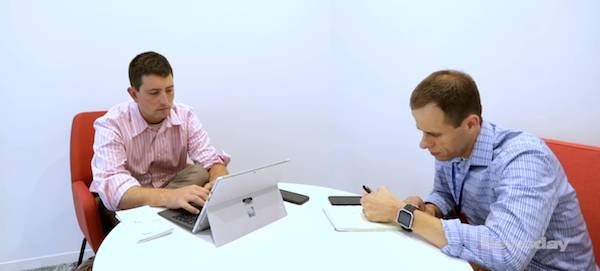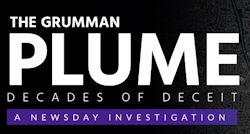SEJournal Online is the digital news magazine of the Society of Environmental Journalists. Learn more about SEJournal Online, including submission, subscription and advertising information.
 |
| An investigation by Newsday’s David M. Schwartz, above left, and Paul LaRocco, above right, of groundwater contamination at the former Grumman property on Long Island won the pair multiple awards. Image: Newsday staff. |
Inside Story: Reporters Reveal ‘Decades of Deceit’ Over Underground Water Contamination
Even for a well-known environmental problem, dogged reporting can yield new insights. Case in point is an investigation into groundwater contamination at the former Grumman property on Long Island by Newsday’s Paul LaRocco and David M. Schwartz, in which the duo uncovered confidential documents to trace decades of government and corporate coverup.
The project won LaRocco and Schwartz, who work on the investigations desk at Newsday, a second-place prize for Outstanding Investigative Reporting (Large Newsroom or Circulation) in the Society of Environmental Journalists’ 2020 Annual Awards for Reporting on the Environment.
“Although the contamination of the underground water plume has been known for decades,” said SEJ awards judges, “this very well-written entry weaves together the economic and social history of Grumman on Long Island with discoveries of new evidence illuminating what the company and regulators knew and when they knew it. In the process, the reporter unfolds a riveting story in a style that deftly blends exposé with a grim whodunit.”
SEJournal Online recently caught up with LaRocco and Schwartz via email. Here is the conversation.
SEJournal: How did you get your winning story idea?
Paul LaRocco and David M. Schwartz: The plume of groundwater contamination spreading from the former Grumman property in Bethpage, N.Y., had been one of the most closely covered local environmental stories over the preceding decade, as the pollution worsened and more residents took notice. But the deeper history, spanning more than 70 years, had never really been told. At first, we conducted interviews and combed archival material and court records simply to see if there was even a new story to be written. No matter what, our research would have allowed us to provide an expansive, comprehensive account of how the region's worst environmental crisis had come to be. What truly elevated the project was our discovery of an obscure federal civil lawsuit, filed by Grumman's insurers, that contained a trove of meant-to-be-sealed confidential documents. These made clear that the company and regulators had actively misled the public about the contamination's severity and who was responsible, and had long withheld critical information that could have helped stop it from worsening.
SEJournal: What was the biggest challenge in reporting the series and how did you solve that challenge?
LaRocco/Schwartz: Many residents in the area of contamination are convinced that cancers experienced by themselves and loved ones are attributable to what took place at the Grumman site. But absent definitive studies, it was up to us to weigh their feelings (and the known dangers of the chemicals found in high quantities in the groundwater plume) with the fact that we simply cannot conclusively make such a link. So it was a delicate dance between telling their stories without causing undue alarm and not coming off as minimizers, something that would have played right into the hands of the polluters looking to avoid legal and financial responsibility. This required precision in the writing and diligent research of the established science. In the end, we decided to focus that portion of the project more on something that was indisputable: Whether or not the contamination has directly led to increased cancers in the community, this has had a heavy psychological toll on the residents.
‘The polluters had long sought to limit their
formal responsibility and financial investment
in the cleanup. But many of the internal documents …
revealed a far-more extreme effort than we imagined.’
— LaRocco and Schwartz
SEJournal: What most surprised you about your reporting/findings?
LaRocco/Schwartz: We knew that the polluters had long sought to limit their formal responsibility and financial investment in the cleanup. But many of the internal documents — as well as the correspondence with regulators we obtained — revealed a far-more extreme effort than we imagined. In one example, a consultant for Northrop Grumman had provided regulators with a detailed history of waste disposal practices at a parcel of land that had later been donated to the town for a park. But when that land was found not only to be contaminated in the soil but also the source of some of the worst groundwater pollution, the company had another consultant literally rewrite that history to say the disposal activities there "weren't well understood." Finding these things required reading deep into dense regulatory documents that seemed otherwise fruitless.
SEJournal: How did you decide to tell these stories and why?
LaRocco/Schwartz: The revelations from the confidential documents were so shocking that we decided to lead the series with a hard news story that sought to capture the sweep of our findings and how they led to the problem being as severe as it was today. But we knew the emotional toll on the community was just as important of an element. So that became the second main story on the first day the story ran. Those were followed with an exhaustive four-part series that told the story of the contamination in chronological order. This way, if a reader only read the first two stories (and their sidebars), they'd get the strongest, most urgent findings, but if they dove into the full history, they'd get even greater detail, and hopefully emerge with the shocking depth and breadth of the polluters' and regulators' deception and minimization over decades.
 |
| Screenshot from the Newsday package. Click to enlarge. |
SEJournal: What would you do differently now, if anything, in reporting or telling the series and why?
LaRocco/Schwartz: Some of the people who play a prominent role in fighting this contamination over the years are vibrant characters in their own right. With more time, we could have envisioned sidebars or additional parts that expanded on their stories in a way that allowed readers to feel that they understood them on a deeper level. But the structure of the series didn't really allow that kind of narrative detour.
SEJournal: What lessons have you learned from your project?
LaRocco/Schwartz: When you think you've gotten enough material for your project — or that you've read every document you can read — there's always more to find. By having such a wise and encouraging editor, Marty Gottlieb, we were forced to constantly revisit and challenge our conclusions, which prompted us to read and reread the source material in ways that uncovered things we had missed the first time around.
SEJournal: What practical advice would you give to other reporters pursuing similar projects, including any specific techniques or tools you used and could tell us more about?
LaRocco/Schwartz: When dealing with events spanning such a long period of time, log everything in a timeline and organize documents by date in shared cloud storage systems to allow for easy reference. Include and closely read the previous news coverage to find public statements that could be contradicted by internal documents. Scan everything in digital form to give online designers the most material you can to develop a compelling web presentation. Prioritizing organization isn't the sexiest piece of advice, but it really pays off at the end of a yearlong project like this one, where the fact-checking was intensive in the face of complex topics and heavy scrutiny.
Editor’s Note: The Plume project subsequently won first place for environmental writing in the 2021 National Headliner Awards, was a finalist for excellence in environmental reporting in the 2021 Scripps Howard Awards and was a semi-finalist in the 2021 Goldsmith Prize for Investigative Reporting. It also won numerous state and regional prizes, including a New York Emmy.
Paul LaRocco and David M. Schwartz are reporters on Newsday’s investigations desk. LaRocco joined Newsday in 2010; Schwartz in 2013. Both previously covered municipal government and politics beats for the paper, where their work was honored in various state, regional and national journalism contests. LaRocco, a graduate of Emerson College in Boston, has worked for the (Riverside, Calif.) Press-Enterprise and Record-Journal in Meriden, Conn. Schwartz, a New York University graduate, has worked for papers including the Las Vegas Sun, Las Vegas Review-Journal and The San Bernardino Sun in Southern California. Both are Long Island natives.
* From the weekly news magazine SEJournal Online, Vol. 7, No. 1. Content from each new issue of SEJournal Online is available to the public via the SEJournal Online main page. Subscribe to the e-newsletter here. And see past issues of the SEJournal archived here.














 Advertisement
Advertisement 



